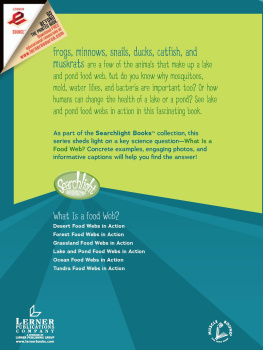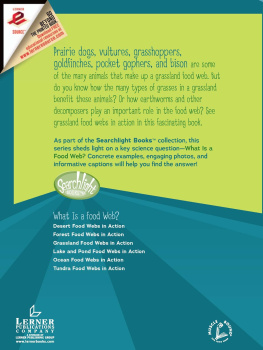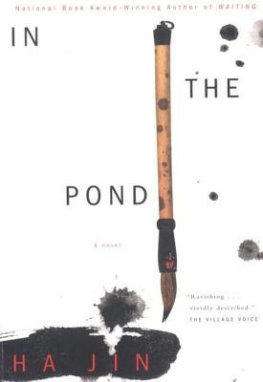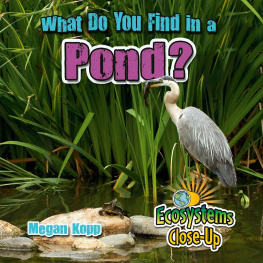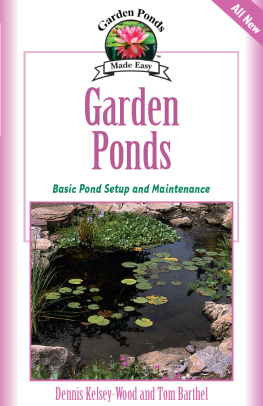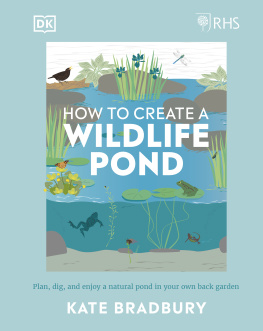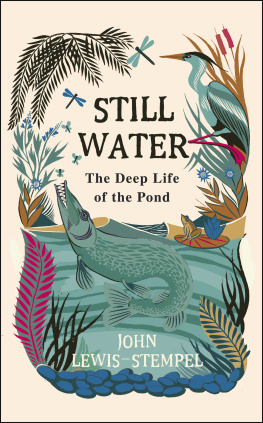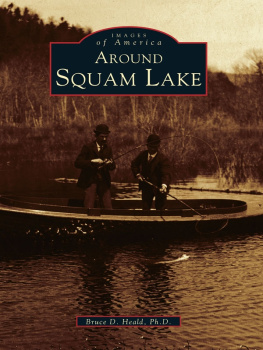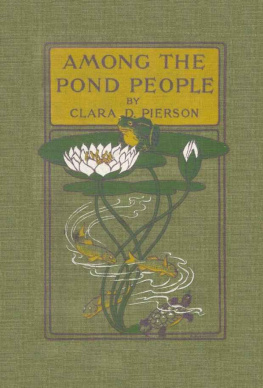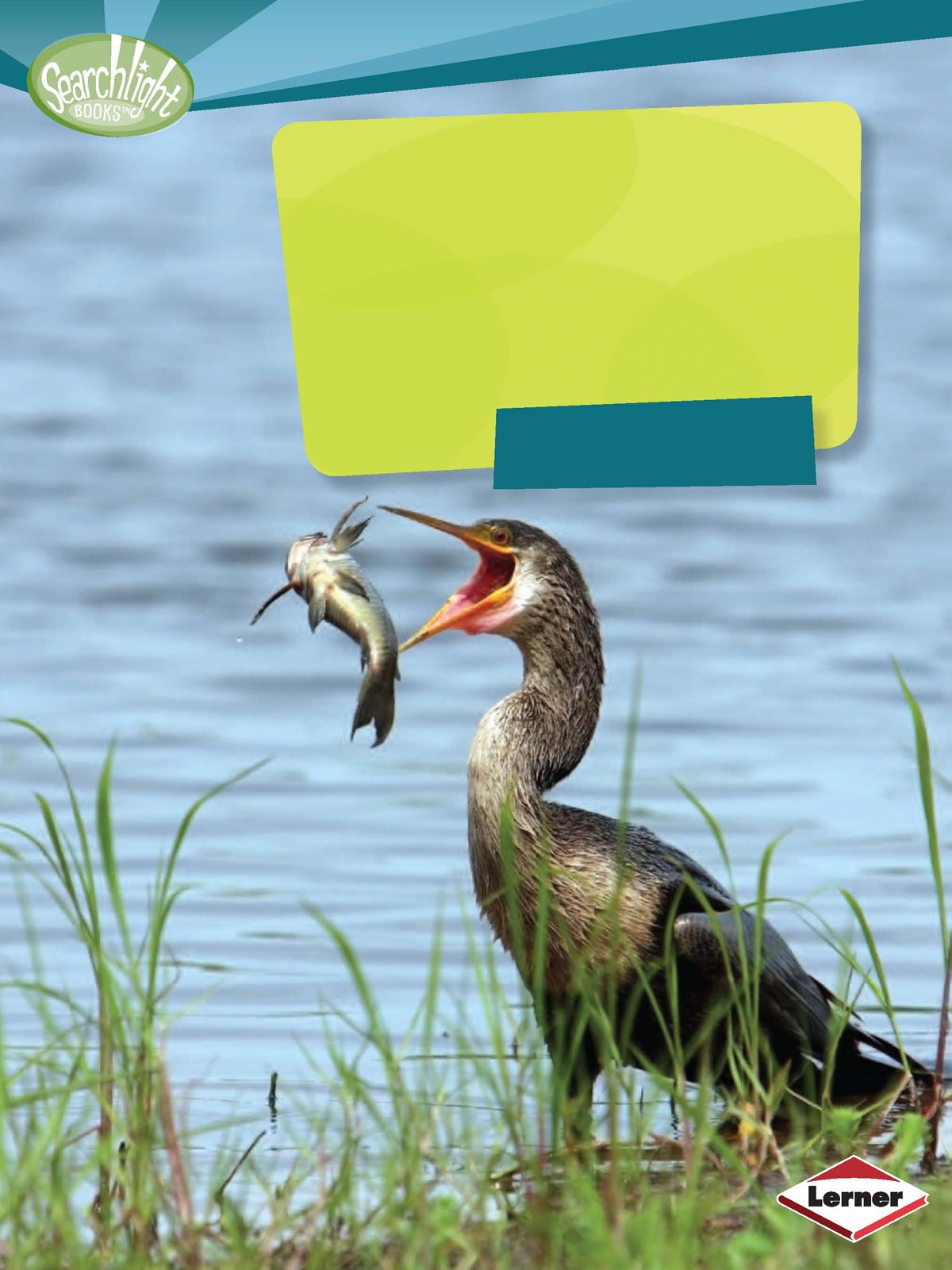Lake
and
Pond
Food
Webs
in Action
Paul Fleisher
Copyright 2014 by Lerner Publishing Group, Inc.
All rights reserved. International copyright secured. No part of this book may be
reproduced, stored in a retrieval system, or transmitted in any form or by any means
electronic, mechanical, photocopying, recording, or otherwisewithout the prior written
permission of Lerner Publishing Group, Inc., except for the inclusion of brief quotations in
an acknowledged review.
Lerner Publications Company
A division of Lerner Publishing Group, Inc.
241 First Avenue North
Minneapolis, MN 55401 U.S.A.
Website address: www.lernerbooks.com
Library of Congress Cataloging-in-Publication Data
Fleisher, Paul.
Lake and pond food webs in action / by Paul Fleisher.
p. cm. (Searchlight bookswhat is a food web?)
Includes index.
ISBN 9781467712569 (lib. bdg. : alk. paper)
ISBN 9781467717762 (eBook)
1. Lake ecologyJuvenile literature. 2. Lake plantsJuvenile literature. 3. Lake
animalsJuvenile literature. I. Title.
QH541.5.L3F58 2013
577.63dc23 2012034112
Manufactured in the United States of America
1 BP 7/15/13
Contents
A LAKE OR POND FOOD WEB
Chapter
LAKES AND
PONDS
A great blue heron wades in a
lake. The tall bird stands very still.
Then it stabs its beak into the water.
It catches a fish and swallows it.
Herons hunt in the shallow water of
lakes and ponds. Many creatures live in
the water.
Others live
along the waters
edge. Plants grow
in the water too.
Insects fly above it.
This bird is a great blue heron.
It has caught a fish. Where
do herons hunt for food?
A young white- tailed
deer has come to a
pond to drink water.
Environments
Lakes and ponds are some of Earths most important
environments. An environment is the place where any
creature lives. The environment includes the air, the soil,
and the weather. It includes plants and animals too.
Plants and animals in lakes and ponds depend on one
another. Some animals eat plants. Other animals are
meat eaters. They eat other animals. When plants and
animals die, they decay. They break down into chemicals.
Some of the chemicals are called nutrients. Living things
need nutrients to grow.
Many fish eat meat. This
bass is eating a frog.
Food Chains and Energy
Energy moves from one living thing to another. A food
chain shows how the energy moves. The energy for life
comes from the sun. Plants store the suns energy in
their leaves, stems, and roots. When an animal eats a
plant, the animal gets some of the suns energy from the
plant. The energy moves farther along the food chain
each time one living thing eats another.
A fish is watching a frog. If
the fish eats the frog, the fish
will get energy from the frog.
Lakes have many food chains. Imagine that a tadpole
eats a plant. Then a sunfish eats the tadpole. A heron
eats the sunfish. When the heron dies, a crayfish eats
its body. The suns energy goes from the plant to the
tadpole. Then it passes to the sunfish. Then it goes to
the heron. Then it goes to the crayfish.
A TADPOLE IS A YOUNG FROG.
THIS TADPOLE IS EATING A PLANT.
Food Webs
But sunfish dont eat only tadpoles. They eat insects and
minnows too. Herons eat many different kinds of fish.
And crayfish eat many kinds of living and dead animals.
An environments food web is made up of many food
chains. A food web shows how all living things depend on
one another for food.
This sunfish is eating
a smaller fish.
Chapter
LAKE AND
POND PLANTS
Green plants
use sunlight
to make food.
Because plants
produce food, they
are called producers.
Plants also make
oxygen. Oxygen is a gas
in the air. All animals need
oxygen to breathe.
Water lilies are green
plants that grow in lakes
and ponds. How do green
plants use sunlight?
Making Food and Oxygen
The way plants make food and oxygen is called
photosynthesis. Plants need carbon dioxide, sunlight, and
water for photosynthesis. Carbon dioxide is a gas in the
air. A plants leaves take in carbon dioxide and sunlight.
The plants roots take in water. The plant uses energy
from sunlight to turn the carbon dioxide and water into
sugar and starch. Sugar and starch are the plants own
food. The plant stores this food in its leaves and roots.
HOW PHOTOSYNTHESIS WORKS
A water lilys leaves turn sunlight, carbon
dioxide, and water into food for the plant.
As the plant
makes food,
it also makes
oxygen. The
oxygen goes into
the air and the
water. Animals
breathe in the
oxygen. They
breathe out
carbon dioxide.
Plants use the
carbon dioxide to
make more food.
This is a young red- spotted
newt. It has gills behind its eyes.
The newt uses its gills to breathe
oxygen that is in the water.
Kinds of Plants
Algae are tiny plants. They float in the water. Algae are
the most important producers in the pond. But most
algae are so small we cant see them.
Sometimes algae piles up in thick
mats. You can see bubbles of oxygen
in this algae mat. The algae made
the oxygen through photosynthesis.

